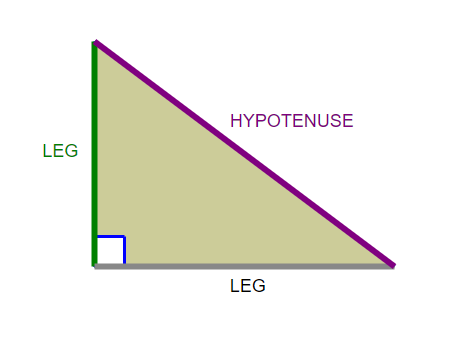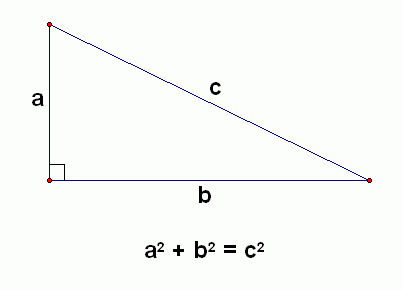 The Pythagorean Theorem
The Pythagorean Theorem
(This lesson also appears in the Algebra I curriculum. If you studied it there, then just quickly review, and move on to the next section!)
A 90° angle is called a right angle. A right triangle is a triangle with a 90° angle.
In a right triangle, the side opposite the $\,90^\circ$ angle is called the hypotenuse and the remaining two sides are called the legs.
The angles in any triangle add up to $\,180^\circ\,.$

In any triangle, the longest side is opposite the largest angle, and the shortest side is opposite the smallest angle. Thus, in a right triangle, the hypotenuse is always the longest side.
The Pythagorean Theorem gives a beautiful relationship between the lengths of the sides in a right triangle: the sum of the squares of the shorter sides is equal to the square of the hypotenuse. Furthermore, if a triangle has this kind of relationship between the lengths of its sides, then it must be a right triangle!

Have fun with many proofs of the Pythagorean Theorem! This applet (you'll need Java) is one of my favorites. Let it load, then keep pressing ‘Next’.
Examples
Note: $x\,$ cannot equal $\,-4\,,$ because lengths are always positive.
The $\,3{-}4{-}5\,$ triangle is a well-known right triangle. Multiplying all the sides of a triangle by the same positive number does not change the angles. Thus, if you multiply the sides of a $\,3{-}4{-}5\,$ triangle by any positive real number $\,k\,,$ then you will still have a right triangle. For example, these are all right triangles:
| $6{-}8{-}10$ | ($\,k = 2\,$) |
| $9{-}12{-}15$ | ($\,k = 3\,$) |
| $1.5{-}2{-}2.5$ | ( $\,k = 0.5\,$ ) |
| $3\pi{-}4\pi{-}5\pi$ | ($\,k = \pi\,$ ) |
| and so on! | |